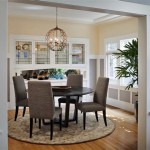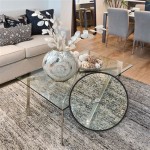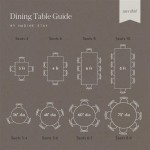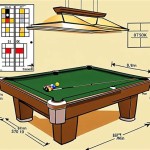Do You Need A Rug Under A Dining Room Table?
The question of whether to place a rug underneath a dining room table is a common one for homeowners and interior designers. While it might seem like a simple aesthetic choice, several functional and practical considerations come into play. Rugs can enhance the visual appeal of a dining space, but they also offer benefits related to noise reduction, floor protection, and overall comfort. Conversely, a rug can introduce challenges related to maintenance, safety, and space limitations. Therefore, it's essential to carefully evaluate these factors before making a decision.
The decision to incorporate a rug under a dining room table should be based on a thorough understanding of the potential advantages and disadvantages. The size of the room, the style of the décor, the type of flooring, and the lifestyle of the occupants all contribute to the appropriateness of a rug in this setting. Thoughtful consideration of these aspects can lead to a choice that is both aesthetically pleasing and practically beneficial.
Aesthetic Enhancement
One of the primary reasons people choose to use a rug under a dining room table is to improve the aesthetic appeal of the room. A well-chosen rug can tie together the various elements of the dining space, creating a cohesive and visually pleasing environment. It can define the dining area within an open-concept layout, providing a sense of separation and structure. The rug serves as an anchor, grounding the table and chairs and preventing them from appearing to float in the room.
The color, pattern, and texture of the rug can significantly influence the overall mood of the dining room. A brightly colored or patterned rug can add vibrancy and energy, while a neutral-toned rug can create a sense of calm and sophistication. Textural variations, such as shag or woven rugs, can add depth and interest to the space. Furthermore, a rug can complement existing décor elements, such as artwork, curtains, and furniture, creating a harmonious and stylish look. Selecting a rug that aligns with the overall design theme of the home is crucial for achieving a unified and aesthetically pleasing result.
A rug can also be used to create a focal point in the dining room. A particularly striking rug, whether due to its color, pattern, or material, can draw the eye and become a conversation starter. It can serve as a visual centerpiece, enhancing the room's overall character and personality. The choice of rug can reflect the homeowner's personal style and preferences, adding a unique touch to the dining space.
Practical Benefits
Beyond aesthetics, rugs provide several practical benefits in a dining room setting. These benefits relate to noise reduction, floor protection, increased comfort, and improved safety. By addressing these practical concerns, a rug can enhance the functionality and livability of the dining space.
Noise reduction is a significant advantage, especially in homes with hard flooring such as wood, tile, or laminate. The rug's soft fibers absorb sound, diminishing echoes and muffling the noise of chairs scraping against the floor. This can create a more peaceful and relaxing dining experience, particularly in larger rooms or open-concept spaces where sound tends to travel easily. The rug acts as a sound dampener, contributing to a more comfortable and acoustically balanced environment.
Floor protection is another critical benefit. A rug safeguards the flooring underneath the dining table from scratches, dents, and spills. Chairs moving in and out can cause wear and tear over time, especially on hardwood floors. A rug provides a protective barrier, preventing direct contact between the furniture and the floor surface. This can extend the life of the flooring and reduce the need for costly repairs or replacements. In case of spills, the rug can absorb the liquid, preventing it from seeping into the floor and causing stains or water damage.
Comfort is also enhanced by the addition of a rug. It provides a softer surface underfoot, making the dining area more inviting and comfortable. This is particularly beneficial in rooms with hard, cold flooring, where the rug adds a layer of warmth and coziness. The rug can also improve the tactile experience of the dining space, making it more pleasant to walk on and sit near the table. This increased comfort can contribute to a more enjoyable dining experience for both residents and guests.
Safety is another important consideration. A rug can prevent slips and falls, particularly for children and elderly individuals. Hard floors can be slippery, especially when wet, and a rug provides added traction and grip. This reduces the risk of accidents and injuries, making the dining area a safer space for everyone. A well-placed rug can also visually define the dining area, alerting people to the presence of furniture and preventing them from tripping.
Potential Drawbacks
Despite the many advantages, there are also potential drawbacks to consider when deciding whether to place a rug under a dining room table. These drawbacks relate to maintenance, safety hazards, size considerations, and cost implications. Addressing these concerns proactively can help mitigate any negative impacts.
Maintenance is a primary concern. Dining rooms are prone to spills and food debris, and a rug can easily become stained or dirty. Cleaning a rug can be challenging, especially if it is large or made of delicate materials. Regular vacuuming is essential to remove crumbs and dirt, but deep cleaning may be required periodically to remove stains and odors. Certain rug materials, such as wool or silk, require professional cleaning, which can be costly and time-consuming. Choosing a rug material that is stain-resistant and easy to clean is crucial for minimizing maintenance efforts. Synthetic fibers, such as nylon or polypropylene, are often a good choice for dining room rugs due to their durability and ease of cleaning.
Safety hazards can also arise if the rug is not properly secured. A rug that slides or bunches up can create a tripping hazard, especially for children and elderly individuals. Using a rug pad underneath the rug is essential to prevent it from slipping and sliding. The rug pad provides a non-slip surface that keeps the rug firmly in place, reducing the risk of accidents. Additionally, it's important to ensure that the edges of the rug are lying flat to prevent people from tripping over them. Regularly checking the rug and rug pad can help identify and address any potential safety issues.
Size considerations are important for both aesthetic and practical reasons. A rug that is too small can make the dining area look disjointed and unbalanced. A rug that is too large can overwhelm the space and make it feel cramped. The general rule of thumb is that the rug should be large enough to accommodate all the chairs when they are pulled out from the table. This ensures that the chairs remain on the rug even when they are in use, preventing them from scraping against the floor. Measuring the dining area and the dining table is crucial for determining the appropriate rug size.
Cost is another factor to consider. Rugs can range in price from relatively inexpensive to very expensive, depending on the material, size, and design. Adding a rug pad will also add to the overall cost. It's important to set a budget before shopping for a rug and to consider the long-term costs of maintenance and cleaning. Cheaper rugs may wear out more quickly and require more frequent replacement, while more expensive rugs may require more specialized cleaning and care. Weighing the initial cost against the long-term benefits and maintenance requirements is crucial for making an informed decision.
In conclusion, the decision of whether to include a rug under a dining room table depends on a variety of factors. Aesthetics, practical considerations, and potential drawbacks need to be weighed carefully. By thoroughly assessing these aspects, one can make an informed decision aligning with their needs, preferences, and lifestyle.

Should You Put A Rug Under Dining Table Furniturebox

What Size Rug Under Dining Table Here S The Best Way To Find Righ

Simple Rules For Dining Room Rugs Floorspace

People Can T Decide Whether Rugs Belong In The Dining Room Or Not

Should You Put A Rug Under Dining Table Furniturebox

Rules Of Thumb For Rugs Under Round Dining Tables Inspiration

6 Rules For Choosing A Dining Room Rug Pretty Sources Stonegable

People Can T Decide Whether Rugs Belong In The Dining Room Or Not

How To Choose A Family Friendly Dining Room Rug

10 Tips For Getting A Dining Room Rug Just Right Houzz








